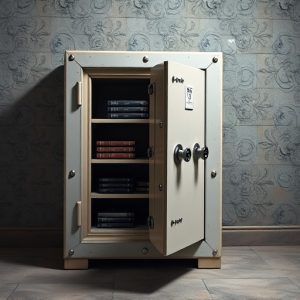Camouflaged Protection: The Rise of Can Safes
The modern home security landscape has been revolutionized by the introduction of 'camouflage s…….
The modern home security landscape has been revolutionized by the introduction of 'camouflage safes,' which are designed to blend into domestic environments. These innovative safes, which can resemble everyday objects from kitchen cans to children's toys, provide both a functional and aesthetic solution for securing valuables. Their design is meticulous, carefully crafted to visually integrate with the surroundings while maintaining high-security standards. This approach allows homeowners to securely store items without disrupting their home's ambiance, making safes that look like something else an essential security measure for those who value both safety and style. The stealth storage solutions are not just about hiding valuables; they are a testament to the ingenuity of modern safe design, which prioritizes discreet protection without compromising on functionality or visual coherence within any setting. These safes offer robust security through sophisticated locking systems and high-grade materials, ensuring that treasured items remain protected from both human intruders and environmental risks.
In an era where security and design intersect, innovative safes that look like everyday objects have emerged as a sophisticated solution for both protection and aesthetics. This article delves into the intriguing world of can-style safes—a novel approach to secure valuables without compromising on home or office ambiance. We’ll explore the design innovations behind these stealthy storage solutions, their functionality, and how they blend seamlessly into everyday life. From understanding the engineering feats that make them robust protectors to appreciating their ability to serve as tasteful decor, can safes represent a harmonious fusion of safety and style. Join us as we uncover the layers behind these cleverly disguised containers and examine why they are becoming an increasingly popular choice for security-conscious individuals seeking a touch of elegance in their living or workspaces.
Unveiling the Camouflage: Safes That Mimic Everyday Objects
In recent years, the field of home security has evolved to include innovative solutions that blend functionality with discreet design. Among these advancements are safes that mimic everyday objects, a concept known as ‘camouflage safes.’ These cleverly designed containers not only offer a secure storage solution for valuables but also serve as convincing decoys to the untrained eye. For instance, a safe that resembles an ordinary kitchen can or a garden can conceals within it invaluable treasures, effectively deterring potential intruders who would simply overlook it amidst actual cans. The allure of these safes lies in their ability to integrate seamlessly into domestic environments without raising suspicion. This camouflage approach is particularly useful in residential settings where maintaining an aesthetic balance is paramount. Moreover, these safes come in various guises, from books and bottles to power strips and even children’s toys, ensuring that they can be placed in plain sight without compromising the security of their contents. The secret to their effectiveness is the meticulous attention to detail in both appearance and functionality, ensuring that the safe only reveals its true purpose to the authorized user. As a result, safes that look like something else have become a practical choice for those seeking to protect their belongings while maintaining the integrity of their living spaces’ ambiance.
– Design Innovations in Stealth Storage: The Art of Deception
In recent years, design innovations in stealth storage have revolutionized the way we think about security and concealment. Safes that mimic everyday objects, such as cans, are a testament to the ingenuity of manufacturers who prioritize both safety and subtlety. These cleverly disguised safes offer a dual advantage: they protect valuables while seamlessly integrating into any environment, often going unnoticed by would-be intruders. The art of deception is at the forefront of this niche market, with designers drawing inspiration from an array of seemingly inconspicuous items. By mastering the craft of creating safes that look like something else, these safes become more than mere containers for precious belongings; they are a statement of security that blends artistry with functionality. The tactile similarities to their real-world counterparts, down to the textures and colors, make these stealthy storage solutions incredibly lifelike. This level of detail not only enhances the safe’s concealment but also ensures that it remains a functional object within its context, be it in a home, office, or commercial space. The result is a product that maintains a discreet profile while offering top-tier security for sensitive items.
– Canning Security: A Closer Look at Safe-Can Design and Functionality
Safes that mimic the humble appearance of everyday objects such as cans offer a clever blend of security and inconspicuousness. These safe-cans are meticulously crafted to resemble their namesakes, right down to the ridges and label details, effectively blending into home or business environments without drawing unwanted attention. Their functionality is equally impressive; designed with robust materials and advanced locking mechanisms, these safes provide ample protection for valuable items while maintaining an innocuous exterior. The design ingeniously combines form and function, ensuring that sensitive contents remain secure against potential intruders or environmental hazards. Furthermore, the safe-can’s deceptive exterior deters casual observers, making it less likely to be targeted by thieves who are on the lookout for traditional safes. This innovative approach to home and office security blurs the lines between utility and disguise, offering a practical solution for those seeking to safeguard their belongings with style and subtlety.


